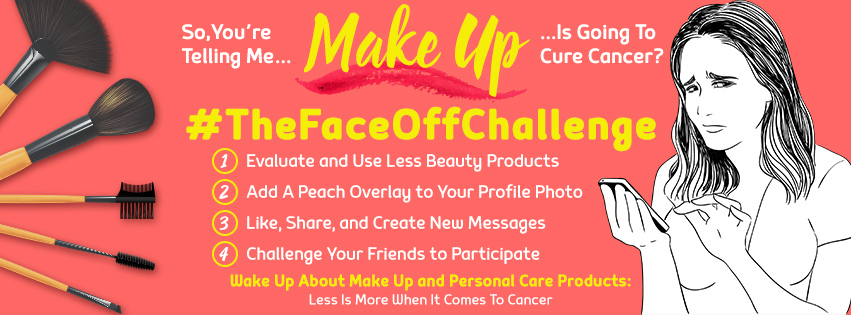
#TheFaceOffChallenge
#TheFaceOffChallenge
Did you know there is a new way social media users can help in the fight against cancer from their computer screen or mobile device? #TheFaceOffChallenge, similar to The Ice Bucket Challenge, is an entirely digital campaign for easing cancer as a health crisis.
#TheFaceOffChallenge does not require physical activity, ice-water stunts, donations, or fundraising from friends, family, and co-workers. Instead, you simply click like and share on Facebook to distribute ready-made messages during National Breast Cancer Awareness Month in October to existing contacts in your network, while adding a peach overlay to your profile photo. For those less technologically savvy, you may upload the line drawing of the woman with peach overlay featured in messages on this page. It’s as simple as that!
Messages share information on supplemental approaches to lessening cancer incidence such as information about toxins in personal care and beauty products that may cause cancer. This project is a result of research at the University of Central Florida and will generate new scholarly knowledge about digital citizenship.
Step 1: Evaluate and Use Less Beauty Products
Apps like Think Dirty and Healthy Living are resources for understanding beauty and personal care products and their relationship to your health. Remember, less is more when it comes to cancer.
Step 2: Add a Peach Overlay to Your Profile Photo
The easiest way to add #TheFaceOffChallenge peach overlay is directly on Facebook. Once you like The Face Off Challenge page, you can easily add a peach overlay to your profile picture by hovering over your profile pic, clicking “Update Profile Picture,” and then selecting one of the peach frames that appear as options in the “Frames” menu.
Or visit https://manytools.org/image/colorize-filter or http://www194.lunapic.com/editor/?action=tint for overlay tools. TIP: Choose web safe colors and enter hex color #f6666.
Or use the line drawing with peach overlay available in the downloads tab at www.FaceOffChallenge.org.
Step 3: Like, Share, and Create New Messages
Like and share our messages. Then, create your own messages and memes with this meme generator tool.
Step 4: Challenge Your Friends to Participate
Tell your friends to like and participate in the challenge on Facebook.
Visit www.FaceOffChallenge.org for more information and tools for participation. You will also want to like the Facebook Page!
Ribbon Cutting
Ribbon Cutting
Welcome to Ribbon Cutting, a game created to defamiliarize the hegemonic narrative and key concepts of the pink ribbon breast cancer movement in order to create a space for players to insert new opinions and pursue additional directions toward curing breast cancer.
Polyvocal Digital Discourse: A Review of Shifman’s Memes in Digital Culture
Polyvocal Digital Discourse: A Review of Shifman’s Memes in Digital Culture
Introduction:
The term Internet meme conjures images of strangers and friends “planking,” remaking “Gangnam Style,” and participating in Occupy Wall Street’s “We are the 99 Percent.” Many debate whether these seemingly trivial digital memes are deserving of serious academic attention. Memes in Digital Culture, written by Limor Shifman and published as part of the MIT Press Essential Knowledge Series in 2014, examines this up-to-date topic that may not have received as much thoughtful attention as it should. Similar to “researchers such as Michele Knobel, Colin Lankshear, Lance Bennett, Ryan Milner, and Jean Burgess” Shifman advocates for practical studies of memes (6). With the recent publication of a special issue of the Journal of Visual Culture on Internet Memes in December 2014, this topic is clearly gaining validity in academic discourses and Shifman is a serious contributor to research on communicative dimensions of Internet memes (Nooney and Portwood-Stacer 251).

Multiliteracies for Inclusive Technologies: A Case Study on Location-Based Services and Domestic Violence Survivors
Multiliteracies for Inclusive Technologies: A Case Study on Location-Based Services and Domestic Violence Survivors
Abstract:
Location-based services on smartphones connect users with real-time relevant information such as maps, directions, recommendations, reviews, and opportunities to connect socially. At the same time, these applications supply the network with users’ personal and location information. Posting on social media allows people to build positive identity socially. However, people barter away small bits of privacy with each user agreement and post. Users’ personal and location information, embedded in code and metadata, is aggregated across sites to produce geodemographic and activity pattern information and is sold as a commodity to advertisers. Beyond marketing, location-based services offer tech-savvy criminals another tool for tracking. This case study investigates users’ privacy concerns and the degree of their concerns about safety, monitoring, and crime; these were found to vary across demographics such as age and gender. Impact to the mainstream public is generally considered low, however, domestic violence survivors emerged as a non-mainstream population whose safety is severely jeopardized by the technology. This case study examines how location-based services impact the safety of domestic violence survivors and reveals ways that emerging technologies might be shaped by a variety of actors, ranging from technology designers, to mainstream and non-mainstream users, to rhetoric and composition professors who strive to be more inclusive and just. This case study elucidates a model for promoting social justice in future technologies by fostering multiliteracies on many fronts.
